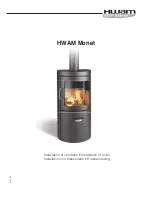
7
PART 2
VENTING
It is extremely important to follow these venting
instructions carefully. Failure to do so can cause severe
personal injury, death or substantial property damage.
Use of cellular core PVC (ASTM F891), cellular core CPVC
or Radel® (polyphenosulfone) in venting systems shall be
prohibited.
2.1
GENERAL VENTING GUIDE
Figure 5: Venting Configurations
The Dynaforce® is a category II condensing appliance, up to
99% efficient unit.
•
The Dynaforce® may be vented with manufactured
prefabricated UL/ULC listed vents of AL29-4C or 316L
stainless steel or with plastic vent certified to UL/ ULC
S636, such as, IPEX System 636 CPVC, IPEX System
636 PVC or IPEX System 636 PP as permitted by local
jurisdictions.
•
The Dynaforce® boiler must be vented and supplied with
combustion and ventilation air as described in this section.
Ensure that the venting and combustion air supply
complies with these instructions regarding the vent
system, air system, and combustion air quality.
•
Provisions for combustion and ventilation air are to be in
accordance with the section “Air for Combustion and
Installation”, Of the National Fuel Gas Code, ANSI
Z223.1/NFPA 54, or clause 8.2, 8.3, 8.4 of “Natural Gas
and Propane Installation Code”, CAN/CSA B149.1.2, or
appliance provisions of the local building codes.
•
The distance of the vent terminal from adjacent buildings,
windows that open and building openings MUST comply
with the latest edition of the National Fuel Gas Code, ANSI
Z223.1, in Canada, the latest edition of CAN/CGA
Standard B149 Installation Code for Gas Burning
Appliances and Equipment.
•
Vent connection is made directly to the flue outlet opening
on the back of the unit.
•
For indoor installations venting must be in accordance with
Part 7, Venting of Equipment, of the National Fuel Gas
Code, ANSI Z223.1, or Section 7, Venting of Equipment
and Air Supply for Appliances, of the CAN/CGA B149,
Installation Codes, or applicable provisions of the local
building codes.
•
Horizontal runs of vent pipe shall be securely supported
(approximately every 4 feet) to prevent sagging and
maintain a minimum upward slope of ¼" per foot from the
appliance to the vent terminal.
•
The weight of the venting system must not rest on the
unit. Adequate support of the venting system must be
provided in compliance with local codes and other
applicable codes.
•
All connections should be secured and sealed per the
vent manufacturers specifications. When a Positive
vent system is disconnected for any reason, the flue
must be reassembled and resealed according to the
vent manufacturer’s instructions.
•
Do not use an existing chimney as a raceway if
another appliance or fireplace is vented through the
chimney.
2.1.1
CATEGORY II AND CATEGORY IV VENTING
A Category II venting system operates with a negative
pressure in the vent.
The Category IV venting system operates with positive
pressure generated by the internal combustion air fan
which operates the combustion process and also exhausts
the flue products from the building.
•
The Category II flues from multiple appliances can be
combined into a common vent, this special venting
system must be engineered by venting manufacturer
and to be approved by local authority.
•
The Category IV flues from multiple appliances CAN
NOT be combined into a common vent.
•
The Category IV flue must be a dedicated stack.
•
The Category IV Flue appliance must have all vent
joints and seams sealed gas-tight
•
The flue products in the vent system will be cooled
below their dew point and form condensate in the flue
and must use AL29-4C, 316L Stainless, S636 CPVC,
and S636 PVC and PPE up to 12” diameter.
•
The flue from a Category II and IV vent system must
have a condensate drain with provisions to properly
collect, neutralize and dispose of any condensate that
may occur
.
2.1.2
VENTING GUIDELINES FOR CATEGORY II
AND/OR IV VENTING
•
The installed length of the positive pressure category
IV flue from the appliance to the point of termination,
outside of the building, must not exceed a maximum
of 100 equivalent feet (30.5M) in length. Depending
on diameter and centerline radius subtract from 7 to
19 feet per 90° elbow using published data. Subtract
half this value for each 45° elbow.
•
For site conditions exceeding 100 equivalent feet an
engineered vent system approved by the local
authority will be required.
•
The flue may terminate either vertically at the roof top
or horizontally on a SIDEWALL. See the information
about the specific vent termination location for
recommended location and clearances.
Outdoor
Venting
Standard
Venting
Sidewall Venting and
Combustion Air Inlet
Содержание DRH300
Страница 2: ......
Страница 6: ......
Страница 38: ...32 13 Place toggle switch setting to REMOTE for remote operation if required...
Страница 69: ...63 PART 12 EXPLODED VIEW 19 1 2 3 4 5 6 7 8 9 10 11 12 13 14 15 16 17 18 20...
Страница 70: ...64 21 22 23 24 26 35 34 33 32 31 30 29 28 27 25 36 37 38 39 40 42 43 56...
Страница 77: ...71 PART 13 ELECTRICAL DIAGRAMS...
Страница 78: ...72...
Страница 79: ...73...
Страница 81: ...75...
Страница 82: ...76...
Страница 83: ...77...
Страница 86: ......














































